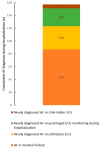Atrial Fibrillation Detected by Implantable Monitor in Embolic Stroke of Undetermined Source: A New Clinical Entity
- PMID: 36233608
- PMCID: PMC9571950
- DOI: 10.3390/jcm11195740
Atrial Fibrillation Detected by Implantable Monitor in Embolic Stroke of Undetermined Source: A New Clinical Entity
Abstract
Background: High incidence of covert paroxysmal atrial fibrillation (CPAF) detected by an implantable cardiac monitor (ICM) is expected in embolic stroke of undetermined source (ESUS) patients. This study aimed to determine the CPAF rate in an ESUS cohort using ICMs and compare stroke characteristics of patients with CPAF to those with known or inpatient-diagnosed AF (KIDAF).
Methods: ESUS patients with ICMs were enrolled. ESUS diagnosis was defined as a non-lacunar stroke in the absence of symptomatic atherosclerotic stenosis (≥50%), no major-risk cardioembolic source, and no other specific cause. ESUS characteristics of patients with CPAF were compared to ESUS patients without CPAF and to KIDAF stroke patients.
Results: During the median follow-up of 476 (371-615) days, CPAF was newly detected in 38/163 (23.31%) patients within 236 (115.50-510.75) days after the stroke. CPAF was independently associated to older age, coronaropathy, left atrial dilation, and atrial hyperexcitability, but not to stroke severity. Compared to KIDAF strokes, ESUS with CPAF had lower rates of proximal occlusion leading to milder clinical severity (NIHSS: 3.00 (1.00-8.25) vs. 14.50 (6.00-21.00)).
Conclusions: Our study revealed a high proportion of CPAF in ESUS. We highlight that CPAF is a distinct clinical entity compared to KIDAF based on differences in stroke characteristics and AF diagnosis temporality.
Keywords: ESUS; atrial fibrillation; cardiac monitoring; stroke; stroke prevention.
Conflict of interest statement
The authors declare no conflict of interest.
Figures
Similar articles
-
Value of HAVOC and Brown ESUS-AF scores for atrial fibrillation on implantable cardiac monitors after embolic stroke of undetermined source.J Stroke Cerebrovasc Dis. 2024 Jan;33(1):107451. doi: 10.1016/j.jstrokecerebrovasdis.2023.107451. Epub 2023 Nov 22. J Stroke Cerebrovasc Dis. 2024. PMID: 37995501 Review.
-
Atrial fibrillation in embolic stroke of undetermined source: role of advanced imaging of left atrial function.Eur J Prev Cardiol. 2023 Dec 21;30(18):1965-1974. doi: 10.1093/eurjpc/zwad228. Eur J Prev Cardiol. 2023. PMID: 37431922
-
Differential characteristics, stroke recurrence, and predictors of covert atrial fibrillation of embolic strokes of undetermined source.Int J Stroke. 2018 Feb;13(2):190-194. doi: 10.1177/1747493017724624. Epub 2017 Jul 31. Int J Stroke. 2018. PMID: 28756759
-
Embolic strokes of undetermined source in the Athens stroke registry: a descriptive analysis.Stroke. 2015 Jan;46(1):176-81. doi: 10.1161/STROKEAHA.114.007240. Epub 2014 Nov 6. Stroke. 2015. PMID: 25378429
-
Covert atrial fibrillation and atrial high-rate episodes as a potential cause of embolic strokes of undetermined source: Their detection and possible management strategy.J Cardiol. 2018 Jul;72(1):1-9. doi: 10.1016/j.jjcc.2018.03.002. Epub 2018 Mar 31. J Cardiol. 2018. PMID: 29609876 Review.
Cited by
-
Cardiac Blood-Based Biomarkers of Myocardial Stress as Predictors of Atrial Fibrillation Development in Patients With Embolic Stroke of Undetermined Source/Cryptogenic Stroke: A Systematic Review and Meta-Analysis.J Clin Neurol. 2024 May;20(3):256-264. doi: 10.3988/jcn.2023.0068. Epub 2024 Jan 1. J Clin Neurol. 2024. PMID: 38171502 Free PMC article.
References
-
- Hart R.G., Diener H.-C., Coutts S.B., Easton J.D., Granger C.B., O’Donnell M.J., Sacco R.L., Connolly S.J., Cryptogenic Stroke/ESUS International Working Group Embolic strokes of undetermined source: The case for a new clinical construct. Lancet Neurol. 2014;13:429–438. doi: 10.1016/S1474-4422(13)70310-7. - DOI - PubMed
LinkOut - more resources
Full Text Sources




